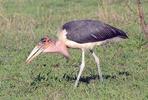
Appearance
Leptoptilos crumeniferus is a large, unusual looking bird. In addition to hollow leg bones, marabou storks have hollow toe bones. In such a large bird, this is an important adaptation for flight. The African Marabou storks reach a wing span of 2,6 metres and a height of 1,5 metres. Marabou storks are bald-headed.
Males can be identified by their large air sacs. In addition, males are generally slightly larger and taller than females. Very large, heavy-bodied stork with a massive conical bill. Sexes are alike in coloration. They are bare, dull and have a red-spotted head with long black legs. They are mainly dark grey above and white below.
Juvenile has similar colouration but is duller. Immature birds have a woolly covering on their heads and do not gain the black in their plumage until about three-years-old. By four-years the full plumage will have grown in. Its soft, white tail feathers are known as marabou. Its neck and head contain no feathers.
The Marabou stork has a long, reddish pouch hanging from its neck. This pouch is used in courtship rituals. The naked 18-inch inflatable pink sac is particularly conspicuous during the breeding season. It connects directly to the left nostril and acts as a resonator allowing the bird to produce a guttural croaking. While usually silent, the Marabou Stork will also emit a sound caused by beak clacking if it feels threatened.
Diet
They mainly feed on carrion and scraps. Although it doesn't seem to be very sympathic in human eyes, this behaviour is of great importance to the ecosystem they inhabit; by removing carcasses and rotting material, Marabous help avoiding the spreading of pathogenes.
They are scavengers, they eat anything from termites, flamingoes and small birds and mammals to human refuse and dead elephants. They also feed on carcasses with vultures and hyenas.
Breeding
Marabous breed on the treetops, where they build large nests. Like White stork (Ciconia ciconia) they like to be near human settlements. It reaches sexual maturity when it is approximately four years old and usually mates for life.
They are colonial breeders, their nests are a large, flat platform made of sticks with a shallow central cup lined with smaller sticks and green leaves. Usually 2-3 eggs are laid during the dry season. Both sexes incubate; eggs hatch in 30 days. Their young are helpless at birth. Both sexes tend and feed the young. Fledging period is 3-4 months.
Behaviour
Marabou storks are attracted to grass fires. They march in front of the advancing fire grabbing animals that are fleeing. They fly in a majestic way and live mostly solitary or in small groups. Larger groups can be seen near sources of food, while migrating or during the breeding season.
Like the Turkey Vulture, the Marabou Stork defecates upon its legs and feet. It is known that the Turkey Vulture has strong antiseptic properties in their whitewash and indeed this is also the case with the Marabou stork, however their reasons for carrying out this act are different.
Quite simply, it helps assist in regulating body temperature, and also gives the false appearance that the birds have lovely white legs. Like many birds the Marabou Stork also pants when it becomes hot, again to lower its body temperature. These are particularly lazy birds and spend much of their time standing motionless, though once they take flight they are very elegant, using thermal up-draughts to provide the needed lift.
They are not good short-distance flyers. Like other storks they fly with their especially long legs trailing behind, but unlike their cousins they keep their neck tucked well in and bent into a flattened S; this allows the weight of the heavy beak to be taken on the shoulders.
Habitat
Aquatic and open, semi-arid areas. Often associates with humans near fishing villages and garbage dumps.Where Marabou Stork Are Found
The Marabou Stork is found in Africa South of the Sahara.

